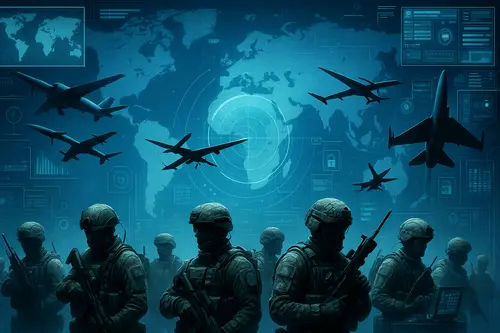
The ongoing conflict between Iran and Israel has really caught the world’s attention, and it’s not just because of the big international players involved. This situation has given us a glimpse into what future battlefields might look like. Cutting-edge drones, artificial intelligence (AI) algorithms, cyberattacks, and missile interception systems are driving this war—unlike past ones—and making it feel like something straight out of a sci-fi movie.
In fact, two specific questions about military aircraft like the Dornier-228, IL-76, and C-17 Globe Master III appeared in the UPSC preliminary exam in 2025. So, this blog takes a deep dive into the technologies that have shaped this conflict and highlights just how rapidly modern warfare is evolving. It’s a must-read for anyone with an interest in defense, technology, or those aiming for UPSC success! Whether you’re a UPSC aspirant, defense enthusiast, or techie—this is a must-read.
Technology In Iran-Israel war
1. Drone Warfare
Iran has rolled out long-range UAVs like the Shahed-129 and the Shahed-136 swarm drones to really put pressure on air defenses. In response, Israel has countered with advanced systems such as the Hermes 900 and mini-drones designed for stealthy operations. AI coordination equips these formidable drones, enabling them to launch relentless attacks. As a result, the battlefield has shifted to the skies.
Iran’s Drones:
Iran’s Shahed 129 and Shahed 149—often called “Gaza”—are powerful long-range drones built for both spying and striking. They carry precision-guided weapons, allowing them to hit targets with deadly accuracy and effectiveness.
The Shahed 136 steps in as a kamikaze drone, launched in swarms to flood and overwhelm enemy air defenses with sheer numbers. Iran frequently uses the Shahed-136 in large quantities to saturate opposing systems, and since they’re relatively inexpensive to produce, they’re a smart choice for large-scale operations.
Lastly, we have the Mohajer 6. These armed UAVs not only come with the ability to conduct surveillance but also pack a punch when it comes to their offensive capabilities.
Israel’s Drones:
The Hermes 900 is quite the adaptable drone, shining when it comes to real-time data transmission. With a remarkable flight time of up to 36 hours, as noted by BulgarianMilitary.com, this drone can reach altitudes of 30,000 feet and carry a variety of payloads, including electro-optical/infrared sensors, radar systems, and electronic warfare equipment. Both the Indian Navy and Army are currently using them.
Next up is the Skylark—a lightweight tactical drone built for urban surveillance. It’s so compact that a single soldier can carry and launch it with ease.
On the other side, Mossad is reportedly using Micro UAVs for covert sabotage missions inside Iran. Intelligence sources suggest that these tiny drones form part of a secretive “Beehive Network,” actively carrying out cyber-espionage and intelligence-gathering missions.
On the tactical front, Iran has been deploying swarms of kamikaze drones, while Israel is using advanced drones for precise counterattacks and real-time aerial intelligence.
2. Missile Defense
Israel’s missile defence includes Iron Dome, David’s sling and Arrow 2/3 had been a strong pillar throughout the tustle giving almost 90% success rate. Iran, however, launched the hypersonic Fattah-1, which challenged existing defense limits. Therefore, this duel marked a major leap in missile warfare.
Israel’s Systems:
The Iron Dome is a short-range defense system that intercepts rockets, artillery shells, and mortars aimed at Israeli cities. It works well in all kinds of weather and can tackle multiple threats at once.
Israel developed the Arrow 2 and Arrow 3 systems to counter long-range threats like ballistic missiles. Arrow 3 is the more advanced version, capable of taking out missiles even beyond the Earth’s atmosphere, while Arrow 2 focuses on intercepting those at lower altitudes.
Israel developed David’s Sling to tackle medium-range threats, including tactical ballistic missiles and cruise missiles. It fills the gap between the Iron Dome and Arrow systems, ensuring comprehensive coverage across different ranges and capabilities.
Iran’s Offense:
The Fattah-1 missile has an impressive speed of Mach 13 to 15, which translates to about 10,000 to 12,000 mph or 16,000 to 19,000 km/h. This incredible velocity makes it a real challenge to intercept. When you add in its capability to make quick directional changes mid-flight, it really cuts down the time available for any interception attempts.
As for the Fateh and Shahab missile series, these are short-range missiles that come with a variety of ranges and guidance systems. This includes models like the Fateh-110, Fateh-313, Zolfaghar, and more.
The Shahab series, which has historically used liquid fuel, features the Shahab-1, Shahab-2, and Shahab-3, with the latter being classified as a medium-range missile. On a related note, Israel has successfully intercepted over 90% of Iranian missiles, thanks to their use of radar-guided AI interceptors and real-time defense coordination.
3. Air Superiority: Fifth-Gen Fighters vs Legacy Jets
Israel’s Advanced Aircraft Fleet
- F-16I “Sufa”– The F-16I “Sufa” is a multirole combat aircraft specially designed for deep-strike missions. It works in sync with UAVs and surface-based radar systems, making it highly effective in modern warfare. The Sufa delivers sharp air-to-ground attacks and provides rapid aerial surveillance, giving Israel a strong offensive and defensive edge.
- F-35I “Adir”(Fifth-generation stealth fighter)– The F-35I “Adir” is Israel’s customized version of the American F-35—a fifth-generation stealth fighter. Built for radar-evading deep strikes, it uses precision-guided munitions to take out targets with extreme accuracy. What makes it even more powerful is its ability to share real-time target data with other air and ground units. It also plays a leading role in electronic warfare, often working closely with cyber units during missions.
- Fifth-Generation Edge– While most countries, including India, still lack access to fifth-generation combat platforms, Israel has set itself apart. Its air force enjoys a major edge thanks to advanced stealth tech, AI-assisted flight systems, and fully networked combat platforms. This technological strength is further enhanced by satellite-guided coordination and electronic jamming systems, allowing Israel to maintain unmatched dominance in its airspace.
Iran’s Aerial Capabilities
- F-14 Tomcats– Originally developed by the U.S. before 1979, the F-14 Tomcat was primarily built for interception missions. While it served its purpose well in its time, it lacks modern stealth features and advanced avionics, making it less suited for today’s high-tech warfare.
- Kowsar Fighter Jet– The Kowsar is Iran’s indigenously developed fighter jet, modeled after the U.S. F-5 from the 1960s. It’s mainly used for ground attacks and short-range defense missions. While it marks a step forward in Iran’s domestic defense industry, it still falls short in critical areas—especially in stealth technology and radar evasion.
- Sukhoi Su-35 (from Russia)– The Su-35, supplied by Russia, stands as one of the most advanced fighter jets used by Iran. It boasts a powerful radar system, thrust-vectoring engines for superior maneuverability, and long-range missile capability. Despite its strength, the Su-35 has at times struggled to match the stealth and tech superiority of Israel’s F-35s in real combat scenarios.
4. Artificial Intelligence: The Digital Commander
As the world has now entered a digital world with continuously shrinking borders and transparent boundaries, it is not possible to not take AI and cyber attacks into picture already. Artificial intelligence has played a central role in following ways:
–Target prioritization
–Trajectory prediction for missiles
–Drone path correction in GPS-denied zones
–Live battlefield simulation
5. Cyber Warfare: Hacking as a Weapon
Cyberattacks have become one of the most effective ways to cripple an enemy nation—no bullets, no bombs, just code. In modern warfare, they’re impossible to ignore. Iran-Israel war also witnessed numerous hacking attempts and cyber attacks.
Like Israeli hackers group named “Predatory Sparrow” in mid-June 2025 launched a cyber-attack on Iran’s Sepah Bank, Hacked Nobitex (Crypto Exchange), and hindered Financial systems.
In response to that, Iran launched numerous attacks by disrupting the privacy of smart home devices, which targeted Israeli Infrastructure, triggering partial Internet blackouts. However, Representative cyber attacks are mainly DDoS attacks by some hacking groups named as “Mr Hamza”, “TEAM FEARLESS” and “Arabian Ghosts”.
5. Electronic Warfare (EW): Controlling the Invisible
Iran has been using GPS jammers and communication disruptors to throw Israeli drones off course. In turn, Israel has countered with anti-jamming navigation, signal spoofing techniques, and scene-matching missiles that operate independently of GPS.
Electronic warfare has become one of the most vital aspects of modern combat, quietly influencing the outcomes of battles from the shadows.
Geopolitics Meets Tech: Foreign Powers Behind the Screen
Things got hot when U.S. recently came in open support of Israel and provided Israel with real-time satellite intel and THAAD defense system. Whereas Russia has been aiding Iran in shadows by giving them Drone Technology and EW Capabilities.
This reflects the multi-layered nature of modern war—it’s not just between two nations anymore. There are silent tech contributors on both sides.
UPSC Relevance of Technology in Iran-Israel war
After analysing past UPSC trends it is very much evident that UPSC is now leaning more towards technical part of the conflicts like in 2025’s prelims – question about military aircraft like the Dornier-228, IL-76, and C-17 Globe Master III has made this point more clear. So, here are some questions which can be framed regarding the technological aspect of Iran-Israel war.
GS Paper 3: Mention the Iran-Israel war as a case study for cybersecurity, AI in defense, and emerging technologies.
Essay: Topic: “The Changing Nature of Modern Warfare” – Use this conflict as a real-life example.
International Relations: Explain technology’s role in diplomacy, strategic deterrence, and power projection.
Conclusion
The Iran–Israel war of 2025 made one thing clear—modern wars aren’t just fought with soldiers and weapons, but with bots, bytes, and bandwidth. Drones fly where planes can’t, AI makes decisions faster than generals, and a cyberattack can paralyze a nation faster than a missile.
As the world enters a new era of hybrid warfare, staying informed about defense technology isn’t just for military geeks—it’s for every aware citizen.
Enjoyed this analysis? Subscribe to our Telegram for UPSC-ready current affairs breakdowns, science & tech insights, and defense trends.
FAQ’s on Technology in the Iran–Israel War
Drones are central in this conflict. Iran uses Shahed-129, Shahed-136, and Mohajer-6 for surveillance and kamikaze strikes, while Israel counters with Hermes 900, Skylark, and micro-UAVs for precision intelligence and sabotage.
Israel’s Iron Dome, along with Arrow-2/3 and David’s Sling, intercepted over 90% of Iranian missiles. However, Iran’s hypersonic Fattah-1 has challenged interception, pushing missile defense to new limits.
AI algorithms are being used for missile trajectory prediction, drone swarm coordination, and battlefield simulations. This makes decision-making faster than human commanders, reshaping how wars are fought.
Groups like “Predatory Sparrow” hacked Iran’s banks and crypto exchanges, while Iran retaliated by targeting Israeli infrastructure and smart devices. DDoS attacks and data breaches became major weapons.
UPSC is asking more defense-tech questions. The 2025 prelims included military aircraft like Dornier-228 and C-17 Globemaster. This war is a real-world example of drones, AI, cyberwarfare, and missile systems in action—key for GS-3, IR, and essay prep.


Great explanation